You can greatly boost your mental resilience as you age by practicing tai chi, a gentle martial art that bridges ancient wisdom with modern health needs. Research shows tai chi enhances executive functions, improves memory retention, and creates new neural pathways while reducing anxiety and depression symptoms. The mindful movements strengthen core stability, reduce fall risks by up to 50%, and promote better sleep quality and mood regulation. Discover how this adaptable practice transforms aging into a journey of continued growth and energy.
Understanding Tai Chi: Ancient Wisdom for Modern Aging
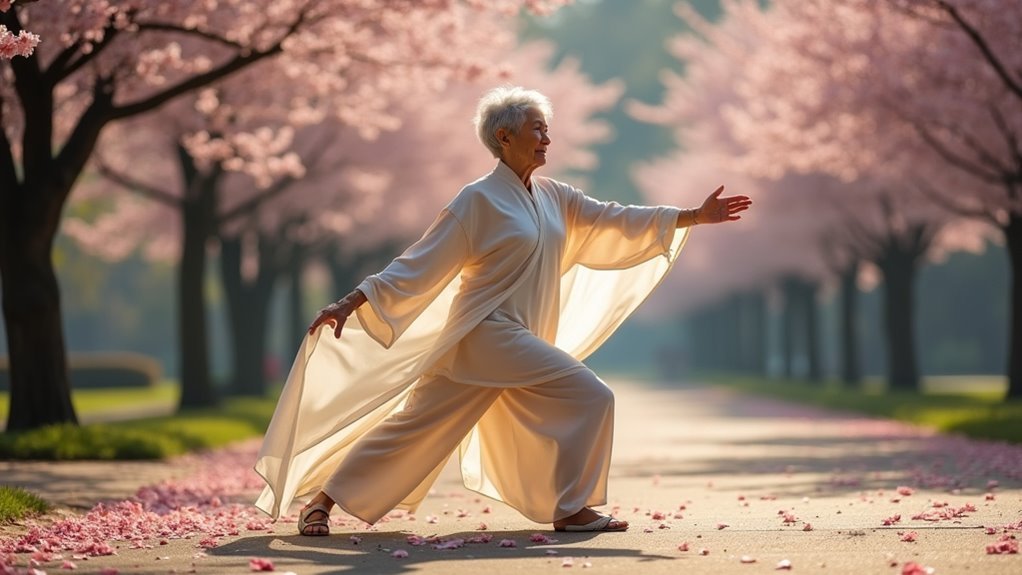
As the years advance and your body begins to feel the natural effects of aging, Tai Chi emerges as a remarkable solution that bridges ancient Chinese wisdom with modern health needs. This gentle martial art transforms from its original self-defense purpose into a powerful tool that addresses your changing physical and cognitive requirements.
Through slow, intentional movements, you’ll develop enhanced balance and flexibility while strengthening your body’s core stability. The practice greatly reduces fall risks by improving your proprioception and body awareness.
For seniors, Tai Chi’s meditative qualities activate your body’s relaxation response, directly supporting both mental well-being and emotional health. Research demonstrates that regular practice enhances cognitive functions including memory and decision-making, making it an invaluable resource for maintaining mental resilience throughout your golden years.
Scientific Evidence Supporting Tai Chi for Senior Mental Health
While you might’ve heard anecdotal claims about Tai Chi’s mental health benefits, rigorous scientific research now provides compelling evidence that validates what practitioners have experienced for centuries.
Studies demonstrate that Tai Chi greatly enhances your cognitive functions, particularly executive abilities like multitasking and decision-making. The practice increases neural connectivity and brain-derived neurotrophic factors, essential for memory preservation and neuroplasticity.
Tai Chi boosts executive brain functions like multitasking while increasing neural connectivity and factors crucial for memory and neuroplasticity.
Research supports these specific mental health improvements:
- Enhanced sleep quality and mood regulation
- Reduced cortisol levels through mindfulness activation
- Decreased anxiety and depression symptoms
- Strengthened social interaction and community connections
The slow, deliberate movements activate your body’s relaxation response while promoting emotional well-being.
Group classes provide vital social interaction that combats loneliness, creating a thorough approach to maintaining your mental resilience as you age.
Building Physical Stability Through Mindful Movement
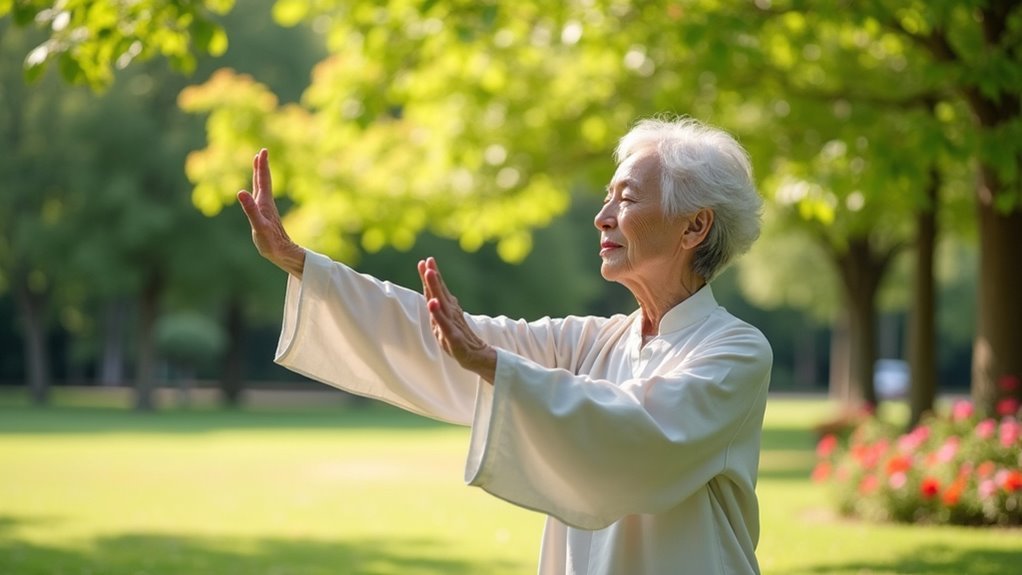
Beyond the mental advantages, Tai Chi transforms your physical stability through movements that deliberately challenge and refine your body’s balance systems.
These deliberate movements reduce fall risks by up to 50% among seniors, addressing falls—a major concern for aging adults. Regular practice greatly enhances your proprioception, enabling quick postural adjustments that prevent tumbles and maintain independence.
You’ll notice substantial improvements in critical balance metrics, including one-leg stance duration and walking speed.
The structured “Tai Chi for Arthritis and Fall Prevention” program demonstrates remarkable results, reducing fall incidents by 43% after 12-26 weeks.
These gentle, low-impact movements strengthen your lower body muscles while engaging your core, essential components for maintaining stable, upright posture as you age.
Your body learns to improve balance naturally through consistent mindful movement.
Enhancing Cognitive Function and Memory Preservation
As you practice Tai Chi’s flowing movements, you’re not just improving your physical balance—you’re actively strengthening your brain’s ability to form and retain memories.
The mindful nature of each deliberate motion creates new neural pathways while reinforcing existing connections throughout your cognitive network.
This enhanced neural connectivity translates into sharper decision-making skills and improved multitasking abilities that help you navigate daily challenges with greater mental clarity.
Memory Through Mindful Movement
Because Tai Chi’s slow, deliberate movements engage the same brain regions responsible for memory formation and decision-making, you’re fundamentally giving your mind a workout while your body flows through each posture.
This mindful movement practice creates powerful neuroplastic changes that directly support cognitive health as you age.
Your Tai Chi practice delivers these memory-enhancing benefits:
- Boosts brain-derived neurotrophic factors that strengthen neural connections
- Improves executive functions like multitasking and memory retention
- Slows cognitive decline in those with mild cognitive impairment
- Activates relaxation response reducing stress that interferes with memory
The mindfulness component of Tai Chi enhances mental clarity by calming your nervous system.
When you’re less stressed, your brain processes and stores information more effectively, creating lasting improvements in memory performance.
Neural Connectivity Enhancement
While you’re developing stronger memory through mindful movement, your brain undergoes remarkable structural changes that extend far beyond memory enhancement alone.
Tai Chi actively strengthens neural connectivity throughout your brain, creating robust pathways that support cognitive health as you age. These enhanced connections particularly benefit executive functions like multitasking and decision-making, areas that typically decline with age.
The mindfulness component of Tai Chi practice stimulates neuroplasticity, encouraging your brain to form new neural networks. You’ll experience increased production of brain-derived neurotrophic factors, essential proteins that protect existing neurons while promoting new growth.
This biological enhancement translates into measurable improvements in cognitive performance, especially if you’re experiencing mild cognitive impairment. Through consistent practice, you’re building mental resilience that helps maintain sharp thinking and cognitive flexibility throughout your golden years.
Emotional Well-Being and Stress Management Benefits
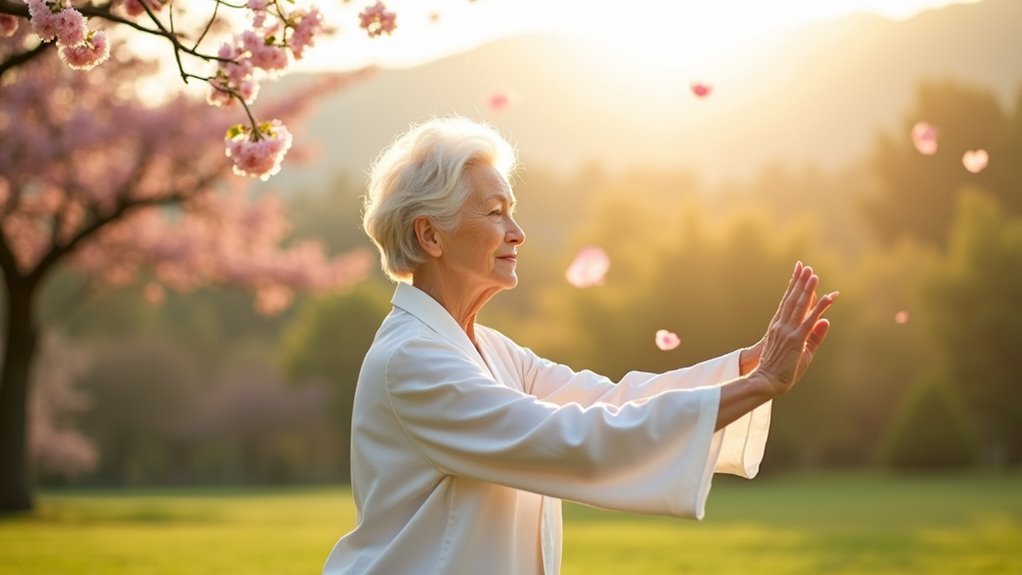
When you practice Tai Chi regularly, your body activates its natural relaxation response, triggering a significant reduction in cortisol levels that directly improves your stress management capabilities.
This ancient practice offers powerful emotional well-being benefits that transform how you handle daily challenges and maintain mental clarity as you age.
The gentle movements provide thorough emotional support through:
- Anxiety and depression relief – Regular practice alleviates symptoms while promoting better emotional regulation
- Enhanced cognitive function – Mindful movements stimulate brain regions that support memory and mental sharpness
- Improved social connections – Group classes foster meaningful social interaction, reducing loneliness and isolation
- Better sleep and mood – Consistent practice creates positive cycles that enhance overall emotional health and well-being
Fall Prevention Through Improved Balance and Coordination
Your balance naturally deteriorates with age, but Tai Chi’s gentle movements can dramatically reduce your fall risk by 20-50% through targeted balance training mechanisms.
You’ll develop enhanced proprioception that allows your body to sense its position in space and make quick postural adjustments automatically.
These improvements in stability translate directly to measurable fall risk reduction, with structured programs showing up to 43% fewer falls in older adults.
Balance Training Mechanisms
As you age, maintaining balance becomes increasingly challenging due to natural declines in muscle strength, sensory input, and reaction time.
Tai Chi offers effective balance training mechanisms that directly address these age-related changes, markedly improving your physical health and mobility.
The gentle movements work through several key mechanisms:
- Enhanced proprioception – The mind-body focus sharpens your body awareness, enabling quick postural adjustments
- Strengthened lower body muscles – Slow, controlled movements build the muscle foundation needed for stability
- Improved coordination – Deliberate movements enhance your ability to control body positioning
- Better reaction time – Regular practice trains your nervous system to respond faster to balance challenges
Through these mechanisms, Tai Chi becomes a powerful tool for fall prevention, helping you maintain independence and confidence as you age.
Proprioception and Stability
Because proprioception acts as your body’s internal GPS system, Tai Chi’s mindful movements create a powerful foundation for fall prevention that goes far beyond simple balance exercises.
When you practice Tai Chi regularly, you’re enhancing your body’s ability to sense position and movement in space, leading to dramatic improvements in stability and coordination.
Research shows you can reduce your fall risk by up to 50% through consistent Tai Chi practice. The slow, deliberate movements foster greater body awareness, allowing you to adjust posture and prevent falls more effectively.
Structured programs like “Tai Chi for Arthritis and Fall Prevention” demonstrate up to 43% reduction in falls over 12-26 weeks. Enhanced proprioception also boosts mental agility, helping you navigate environments confidently while reducing fear of falling.
Fall Risk Reduction
This enhanced body awareness translates directly into measurable fall prevention results that can transform your daily life.
When you practice Tai Chi regularly, you’re actively reducing your fall risk by 20–40%, with some structured programs showing up to 43% fewer falls after just 12-26 weeks.
The prevention benefits you’ll experience include:
- Improved balance scores through slow, deliberate movements that strengthen stabilizing muscles
- Enhanced proprioception enabling quick postural adjustments during daily activities
- Reduced fear of falling as your confidence in movement increases greatly
- Measurable stability gains that translate into safer navigation of stairs, uneven surfaces, and obstacles
For seniors, Tai Chi represents one of the most effective, gentle approaches to fall prevention available today.
Managing Chronic Conditions With Gentle Exercise
Chronic conditions don’t have to sideline your active lifestyle when you discover the transformative power of Tai Chi’s gentle movements. This ancient practice offers remarkable benefits for senior health, addressing multiple chronic conditions simultaneously through accessible, low-impact exercise.
| Chronic Condition | Tai Chi Benefits | Health Improvements |
|---|---|---|
| Knee Osteoarthritis | Pain reduction | Enhanced mobility |
| COPD | Improved lung capacity | Better cardiovascular health |
| Hypertension | Lower blood pressure | Increased joint flexibility |
You’ll find Tai Chi’s adaptable movements accommodate limited mobility while promoting physical activity safely. Beyond physical improvements, this gentle exercise greatly enhances your mental well-being by reducing anxiety and depression symptoms. The slow, flowing motions provide effective non-pharmacological management for chronic conditions, helping you maintain independence and quality of life.
Social Connection and Community Building Through Practice
When you step into a Tai Chi class, you’re not just beginning an exercise routine—you’re joining a vibrant community that can transform your social well-being as much as your physical health.
Community centers offering Tai Chi create spaces where meaningful social connection flourishes, helping you combat loneliness that often accompanies aging.
Group practice delivers remarkable benefits beyond physical movement:
- Enhanced adherence – Peer support keeps you consistently engaged
- Improved emotional well-being – Shared experiences reduce anxiety and boost mood
- Cognitive benefits – Social interaction stimulates memory and mental agility
- Strengthened community bonds – Sharing journeys creates supportive networks
You’ll discover that practicing together encourages participation while building resilience.
These connections become essential support systems that promote overall health and create lasting friendships with fellow practitioners.
Adapting Tai Chi for Different Mobility Levels
You don’t need to abandon Tai Chi if mobility challenges arise, as the practice easily adapts to accommodate various physical limitations.
Whether you’re dealing with joint issues, balance concerns, or reduced strength, modifications like seated routines and simplified movements can keep you engaged in this beneficial practice.
You’ll find that adaptive equipment and instructor-guided modifications guarantee you can continue experiencing Tai Chi’s advantages regardless of your current mobility level.
Seated Tai Chi Options
How can seniors with mobility challenges still experience the transformative benefits of Tai Chi? Seated Tai Chi offers an accessible solution that doesn’t compromise on effectiveness.
These gentle adaptations allow you to practice while sitting, removing barriers that might prevent participation.
You’ll discover that seated movements still promote balance, flexibility, and strength without standing’s physical demands. Research shows seniors practicing Tai Chi in chairs experience reduced fall risk and improved mental well-being, even with chronic conditions.
Key benefits of seated Tai Chi include:
- Gentle movements designed for limited mobility
- Step-by-step guidance from qualified instructors
- Improved accessibility for broader senior participation
- Significant health benefits including enhanced mental resilience
This adaptation guarantees you won’t miss out on Tai Chi’s transformative power, regardless of physical limitations.
Modified Movement Techniques
Adapting traditional Tai Chi forms doesn’t mean sacrificing their healing power—it means unblocking them for everyone.
Modified movement techniques allow seniors with limited mobility to experience Tai Chi’s benefits through smaller, slower motions that protect arthritic joints while maintaining therapeutic value. You’ll find instructors can customize exercises specifically for your capabilities, emphasizing balance and coordination without straining muscles or joints.
Whether you’re seated or standing with support, these adaptations deliver the same remarkable outcomes as traditional routines—improved flexibility, enhanced balance, and reduced fall risk.
Your participation matters, and modified Tai Chi guarantees varying mobility levels don’t prevent you from joining this ancient practice. These accessible techniques create supportive environments where every senior can safely engage in meaningful physical activity.
Adaptive Equipment Solutions
Strategic tools and equipment can further expand your Tai Chi possibilities beyond modified movements alone.
Adaptive equipment solutions transform your practice by addressing specific mobility challenges you’ll encounter as you age.
Essential tools include:
- Balance aids and resistance bands – Provide stability support while enhancing muscle engagement during movements
- Seated Tai Chi adaptations – Enable full participation from chairs when standing becomes difficult
- Supportive lightweight footwear – Improves stability and reduces joint stress during practice sessions
- Visual aids and instructional guides – Enhance learning through clear movement demonstrations and step-by-step instructions
Props like foam blocks and yoga straps assist with stretching while maintaining proper alignment.
These solutions accommodate varying flexibility and strength levels, ensuring you’ll continue benefiting from Tai Chi regardless of physical limitations that develop over time.
Safety Considerations and Professional Guidance
While Tai Chi offers numerous benefits for aging adults, you’ll want to prioritize safety through proper guidance and preparation.
Professional guidance becomes essential when you’re beginning your practice or managing health limitations. Qualified instructors can modify Tai Chi movements to match your physical abilities and guarantee you’re practicing correctly.
You’ll need to establish proper safety considerations before starting. Always warm up gently to prepare your muscles and joints, stay hydrated throughout practice, and choose non-slip surfaces for your sessions.
Wear loose, comfortable clothing that won’t restrict your movement or create tripping hazards.
If you have limited mobility or joint issues, don’t worry – seated Tai Chi routines provide safe alternatives. Your instructor can tailor movements to accommodate your specific needs, making this ancient practice accessible regardless of your current physical condition.
Starting Your Tai Chi Journey: Practical Steps Forward
Taking your first steps into Tai Chi doesn’t require extensive preparation, but choosing the right approach will set you up for long-term success. This gentle physical activity offers remarkable accessibility for older adults seeking improved well-being.
Tai Chi’s gentle approach makes it remarkably accessible for older adults beginning their wellness journey without extensive preparation.
To begin your practice effectively:
- Find suitable classes at community centers or senior programs that match your fitness level
- Dress appropriately in loose clothing and flat shoes for safe, comfortable movement
- Start gradually with 10-20 minute sessions a few times weekly, increasing duration as you progress
- Listen to your body and ascertain movements feel smooth and natural without strain
Consider group classes for social connection and motivation. The health benefits of Tai Chi become more pronounced with consistent practice, making community-based programs particularly valuable for maintaining long-term commitment to this transformative exercise.
Frequently Asked Questions
What Is the Best Form of Tai Chi for Seniors?
You’ll find Yang style best for starting out since it’s gentle and slow-moving. If you have arthritis or fall concerns, try Tai Chi for Arthritis and Fall Prevention programs specifically designed for seniors.
What Is a Disadvantage With Tai Chi?
You’ll need significant time commitment for Tai Chi benefits since regular practice is essential. If you have physical limitations or cognitive decline, learning movements can become challenging and frustrating.
What Is the Chinese Exercise for the Elderly?
You’ll find Tai Chi is the primary Chinese exercise recommended for elderly people. It’s characterized by slow, flowing movements that improve your balance, flexibility, and strength while reducing fall risk considerably.
What Happens if You Do Tai Chi Every Day?
You’ll experience improved balance, flexibility, and strength while reducing fall risk by 50%. Your cognitive function enhances, sleep quality improves, anxiety decreases, joint pain lessens, and you’ll develop greater mindfulness with reduced stress levels.
In Summary
You’ve discovered how tai chi offers a gentle path to mental resilience as you age. You’ll build physical stability, sharpen cognitive function, and manage stress through mindful movement. Don’t let mobility limitations hold you back—adaptations exist for every ability level. Start slowly, seek proper guidance, and connect with others who share this journey. You’re taking control of your mental well-being through this ancient practice that’s perfectly suited for modern aging challenges.

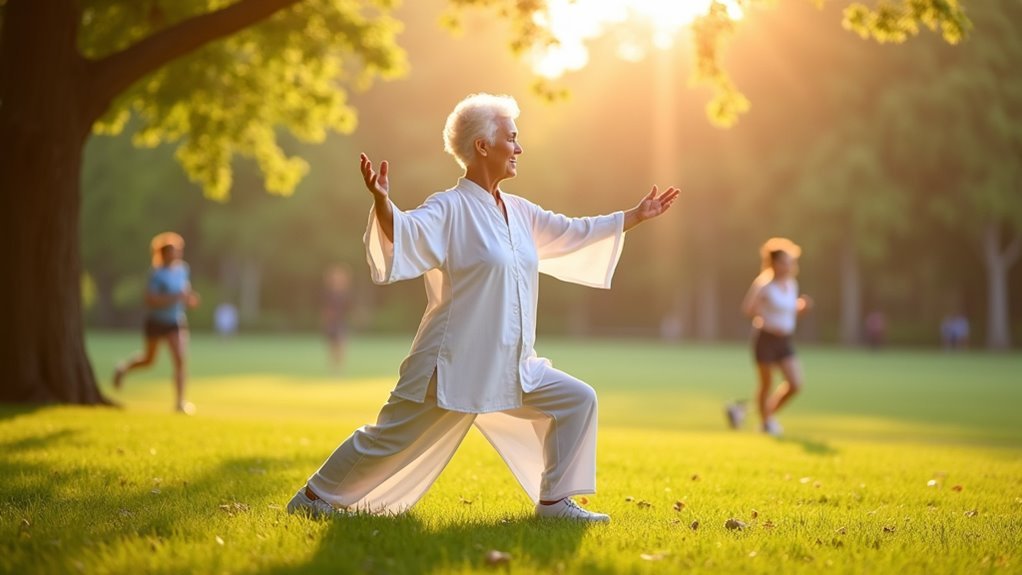
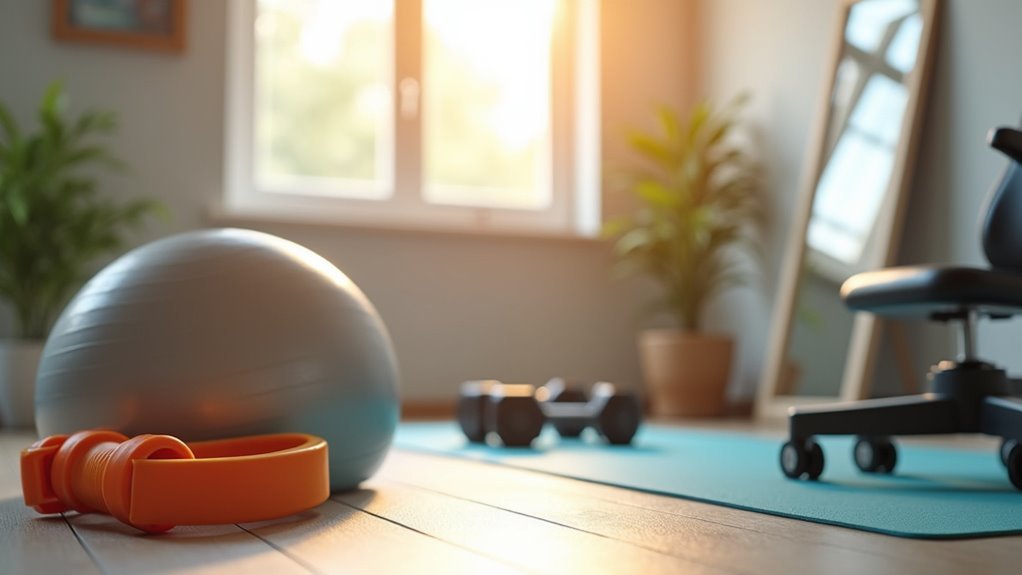
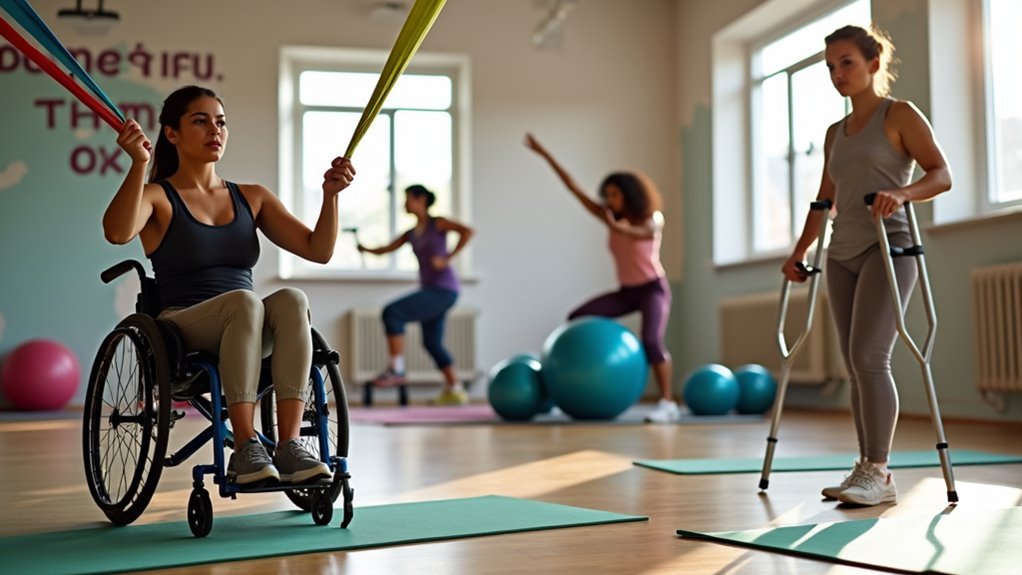
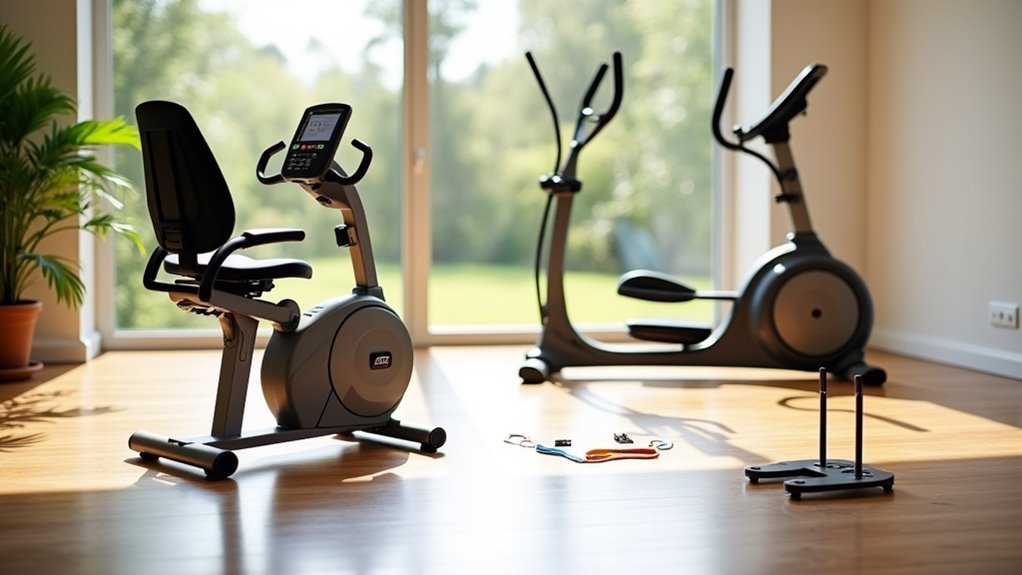
Leave a Reply